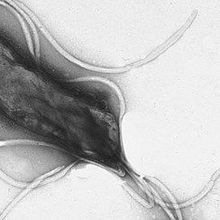Login
Subscribeevolutionary biology, evolution

For Some Male Crickets, Silence Means Survival
Sandhya Sekar | May 29, 2014 | 3 min read
Two island populations of male crickets independently evolved to evade parasites by keeping quiet, and have come up with a way to sneak matings with females that still seek the male courtship song.

Top 10 New Species
Jef Akst | May 23, 2014 | 1 min read
The International Institute for Species Exploration announces its picks of novel species discovered in the past year, including a carnivorous mammal, a tiny shrimp, and a fungus.

Back from the Blacklist?
Jef Akst | May 8, 2014 | 2 min read
Disgraced psychology researcher Marc Hauser, who was found guilty of data fabrication and falsification during his time at Harvard, publishes two new papers.

Not So Different
Tracy Vence | May 1, 2014 | 1 min read
Researchers unearth little evidence to suggest modern humans are superior to their Neanderthal ancestors.

Where the Wild Things Were
Daniel Cossins | May 1, 2014 | 10+ min read
Conservationists are reintroducing large animals to areas they once roamed, providing ecologists with the chance to assess whether such “rewilding” efforts can restore lost ecosystems.

A Wilder Europe
Daniel Cossins | Apr 30, 2014 | 1 min read
An organization hopes to restore natural ecological processes by reintroducing large herbivores to the continent.

Evolutionarily Distinct Birds Ranked
Jef Akst | Apr 11, 2014 | 2 min read
Researchers collate a list of the 100 most rare and unique avian species facing extinction.

Week in Review: March 3–7
Tracy Vence | Mar 7, 2014 | 3 min read
The gene behind a butterfly’s mimicry; the evolution of adipose fins; bacteria and bowel cancer; plants lacking plastid genomes

Convergent Fish Fins
Rina Shaikh-Lesko | Mar 5, 2014 | 3 min read
Adipose fins, long considered vestigial, may have evolved multiple times as a key adaptation in some fish, study finds.

Flashy Deep Sea Fish
Rina Shaikh-Lesko | Mar 5, 2014 | 1 min read
Fish with complex light-emitting photophore patterns may be primed to split into new species.

Drosophila’s New Genes
Jef Akst | Jan 23, 2014 | 3 min read
An analysis of the transcriptomes of several fruit fly strains reveals dozens of possible de novo genes in each.

Human-Pathogen Coevolution
Jef Akst | Jan 13, 2014 | 3 min read
Helicobacter pylori strains that share ancestry with their human hosts are less likely to cause severe disease.

New Species Abound
Jef Akst | Dec 25, 2013 | 5 min read
A look at 2013’s noteworthy new species

On The Origin of Flowers
Ed Yong | Dec 19, 2013 | 4 min read
The genome of Amborella trichopoda—the sister species of all flowering plants—provides clues about this group’s rise to power.

Review: The Origin of Species
Jef Akst | Nov 22, 2013 | 3 min read
The Howard Hughes Medical Institute this week released three short films to teach students about evolution and speciation.

Week in Review: November 18–22
Tracy Vence | Nov 22, 2013 | 4 min read
Chilly mice develop more tumors; gut bacteria aid cancer treatment; two Y chromosome genes sufficient for assisted reproduction; HIV’s “invisibility cloak”

It Takes Two
Jef Akst | Nov 21, 2013 | 3 min read
Two genes from the Y chromosome are sufficient to generate male mice capable of fathering healthy offspring via an assisted reproductive technique.

How, If, and Why Species Form
Tim Rogers, Alan J. McKane, and Axel G. Rossberg | Nov 1, 2013 | 4 min read
Biologists have struggled for centuries to properly define what constitutes a “species.” They may have been asking the wrong question—many smaller organisms might not form species at all.

Evolving Pain Resistance
Jef Akst | Oct 24, 2013 | 4 min read
Grasshopper mice harbor mutations in a pain-transmitting sodium channel that allow them to prey on highly toxic bark scorpions.

Week in Review: September 2–6
Tracy Vence | Sep 6, 2013 | 3 min read
More than 320,000 mammalian viruses lurk; evolution of echolocation in bats and dolphins; accumulation of mutations in drug-resistant tuberculosis; senior researchers reluctant to retire